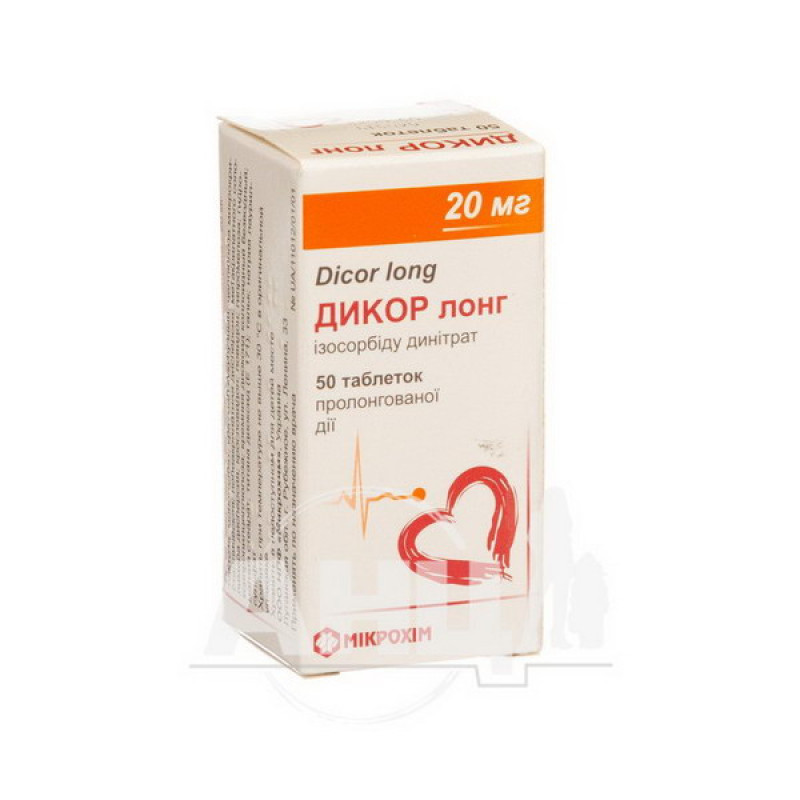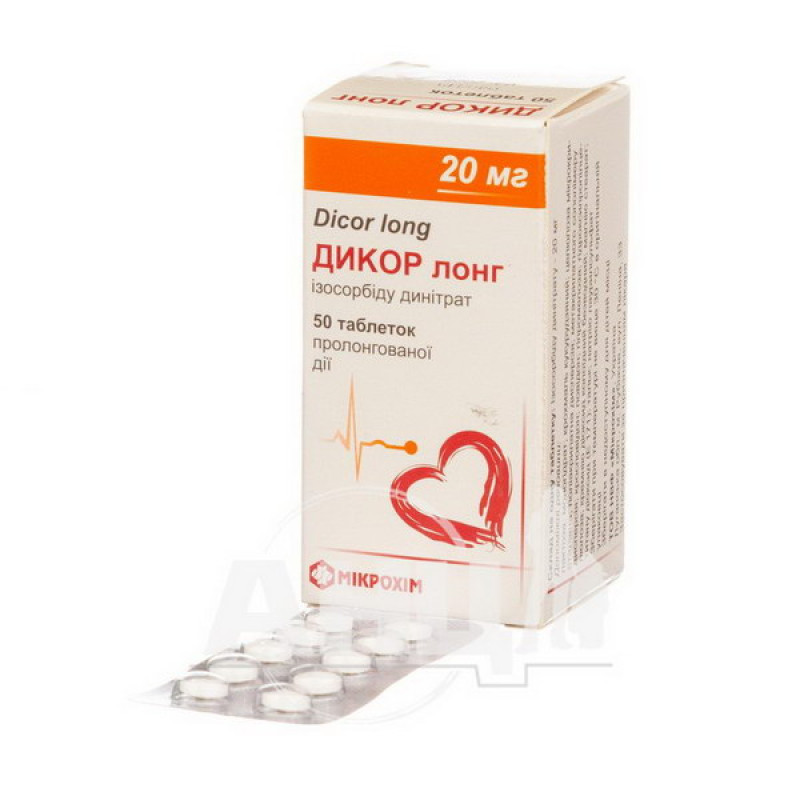Dicor Long prolonged-release tablets 20 mg, can No. 50

Pharmacological properties
Pharmacodynamics
Mechanism of action. Like all organic nitrates, isosorbide dinitrate (ISDN) acts as a nitric oxide (NO) donor. NO leads to relaxation of vascular smooth muscle by stimulating guanylate cyclase and a subsequent increase in intracellular cGMP concentration. In this way, cGMP-dependent protein kinase is stimulated, resulting in changes in the phosphorylation of various proteins in the smooth muscle cell. In turn, this leads to dephosphorylation of myosin light chains and a decrease in contractility.
Pharmacodynamic effect. ISDN causes relaxation of vascular smooth muscle, leading to vasodilation. Venous dilation promotes venous blood deposition and reduces venous return to the heart; thus, ventricular end-diastolic pressure and volume (preload) are reduced.
The action on arteries, and at higher doses on arterioles, leads to a decrease in systemic vascular resistance (afterload). This, in turn, improves cardiac function.
The effect on both pre- and afterload leads to a decrease in oxygen consumption by the heart.
In addition, ISDN causes a redistribution of blood flow to the subendocardial parts of the heart in conditions of atherosclerotic lesions. The latter effect is probably due to selective dilatation of large coronary vessels. Dilatation of collateral arteries caused by nitrates can improve myocardial perfusion in vascular stenosis. In addition, nitrates counteract the appearance and eliminate coronary spasms.
In patients with congestive heart failure, nitrates improve hemodynamics at rest and during exercise. This beneficial effect is due to a number of mechanisms, including reduction of valvular regurgitation (by reducing ventricular dilatation) and reduction of myocardial oxygen demand.
Increasing oxygen delivery while decreasing oxygen demand to the heart muscle reduces the area of myocardial damage. Thus, isosorbide dinitrate may be beneficial for patients with myocardial infarction.
Effects on other organ systems include relaxation of bronchial muscles, gastrointestinal muscles, and muscles of the biliary and urinary tracts; a relaxing effect on uterine smooth muscle has been reported.
Pharmacokinetics. In the gastrointestinal tract, ISDN is released from the prolonged-release tablet slowly, over several hours. The onset of action of the drug is 15-30 min, the time to reach C max is from 15 min to 12 h. The absorption of the active substance is high. Binding to blood plasma proteins is 30%.
The first-pass effect is higher with oral administration.
ISDN is metabolized in the liver to form isosorbide-2-mononitrate (T ½ - 1.5-2 h) and isosorbide-5-mononitrate (T ½ - 4-6 h). Both metabolites are inactive.
Bioavailability. The relative bioavailability of Dicor Long when administered orally is about 80% compared to that of isosorbide dinitrate in the form of tablets, which do not have a prolonged action. After the first pass through the liver, bioavailability is 15-30%.
Indication
Prevention and long-term treatment of angina pectoris.
Application
Dicor long 20 mg: 1 tablet 2 times a day (equivalent to 40 mg of isosorbide dinitrate). The second / next dose should be taken no earlier than 6-8 hours after taking the first dose. With an increased need for nitrates, the daily dose can be increased to 1 tablet 3 times a day with an interval of 6 hours.
Dicor long 40 mg: 1 tablet once a day (equivalent to 40 mg of isosorbide dinitrate). With increased need for nitro drugs, the daily dose can be increased to 1 tablet 2 times a day (equivalent to 80 mg of isosorbide dinitrate). The second / subsequent dose should be taken no earlier than 6-8 hours after taking the first dose.
Dicor long 60 mg: 1 tablet once a day (equivalent to 60 mg of isosorbide dinitrate). With increased need for nitrates, the daily dose can be increased to 1 tablet 2 times a day (equivalent to 120 mg of isosorbide dinitrate). The second / subsequent dose should be taken no earlier than 6-8 hours after taking the first dose.
The maximum daily dose is 120 mg. The duration of treatment is determined individually. The drug is intended for long-term use, it cannot be stopped abruptly.
Elderly patients: There is no evidence that dosage adjustments are necessary for elderly patients.
Pediatric Population: The safety and effectiveness of isosorbide dinitrate in children have not yet been established.
Method of administration: Swallow the tablets without chewing, with a sufficient amount of liquid (for example, a glass of water).
Treatment should begin with low doses, gradually increasing them to the maximum effective. The duration of treatment is determined by the doctor.
Contraindication
Hypersensitivity to ISDN, other nitrate compounds or other components of the drug; acute vascular insufficiency (shock, vascular collapse); cardiogenic shock (if appropriate measures do not maintain a sufficient level of end-diastolic pressure); severe arterial hypotension (systolic blood pressure 90 mm Hg); hypertrophic obstructive cardiomyopathy; constrictive pericarditis; cardiac tamponade; severe anemia; bleeding, severe hypovolemia (ISDN, reducing venous return, can provoke syncope); phosphodiesterase inhibitors (for example, sildenafil, see interactions); soluble guanylate cyclase stimulant - riociguat - should not be used during nitrate therapy (see interactions).Side effects
The frequency of side effects can be defined as very common (≥1/10), common (≥1/100, 1/10), uncommon (≥1/1000, 1/100), rare (≥1/10,000, 1/1000 ), very rare (1/10,000), unknown (cannot be estimated from the available data).
The following side effects are possible when using the drug.
From the nervous system: very often - headache ("nitrate" headache); often - dizziness, drowsiness.
From the cardiovascular system: often - tachycardia; infrequently - increased symptoms of angina pectoris.
From the vascular system: often - orthostatic hypotension; infrequently - vascular collapse (sometimes accompanied by bradyarrhythmia and loss of consciousness); unknown - hypotension.
Gastrointestinal tract: rarely - nausea, vomiting; very rarely - heartburn.
Skin and subcutaneous tissue disorders: uncommon - allergic skin reactions (e.g. rash), flushing; very rare - angioedema, Stevens-Johnson syndrome; unknown - exfoliative dermatitis.
General disorders: often - asthenia.
Severe hypotensive reactions accompanied by nausea, vomiting, restlessness, pallor and increased sweating have been reported with the use of organic nitrates.
During drug therapy, transient hypoxemia may occur due to relative redistribution of blood flow to alveolar areas with hypoventilation. In particular, in patients with coronary artery disease, this may lead to myocardial hypoxia.
Increasing the dose and/or changing the interval between doses may lead to reduced effectiveness or lack of effect.
Reporting of suspected adverse reactions. Reporting of suspected adverse reactions after the registration of a drug is of great importance. This allows for long-term monitoring of the benefit/risk of this medicinal product. Healthcare professionals should report all suspected adverse reactions through the national reporting system.
Special instructions
The drug should be used with caution and under close medical supervision in the following cases:
at low filling pressure, including acute myocardial infarction with impaired left ventricular function (left ventricular failure). It is necessary to maintain pressure not lower than 90 mm Hg. art.; at aortic and/or mitral stenosis; at orthostatic dysfunction; at diseases associated with increased intracranial pressure (possible increase. Until now, such symptoms have been observed only after intravenous administration of high doses of nitroglycerin).The drug should not be used to relieve acute attacks of angina pectoris.
The development of tolerance (reduced efficacy) and cross-tolerance to other nitrate-type drugs (reduced efficacy if the patient has previously taken another nitrate) have been described. To prevent reduced or lost efficacy, prolonged use of high doses (120 mg/day) should be avoided.
Patients on maintenance therapy with the drug should be advised not to take drugs containing phosphodiesterase inhibitors (e.g. sildenafil, tadalafil, vardenafil) due to the risk of uncontrolled hypotension. SSRI therapy should not be discontinued to take drugs containing phosphodiesterase inhibitors (e.g. sildenafil, tadalafil, vardenafil) due to the increased risk of angina attacks (see Side Effects and Precautions).
Due to the fact that the drug contains lactose, it cannot be prescribed to patients with rare genetic diseases such as galactose intolerance, Lapp hereditary lactase deficiency, glucose-galactose malabsorption.
Use during pregnancy and breastfeeding
Pregnancy: Animal reproductive toxicity studies with isosorbide dinitrate at doses toxic to adults have not revealed evidence of fetal toxicity. However, there are no adequate and well-controlled studies in pregnant women.
Given that animal studies may not always predict human effects, the drug should be used during pregnancy only if clearly needed and under the constant supervision of a physician.
Breastfeeding. It is not known whether isosorbide dinitrate passes into breast milk, so it is not recommended for use in women during breastfeeding.
Fertility: There are no data on the effect of isosorbide mononitrate on human fertility.
Children: Do not use in children.
Ability to influence the speed of reaction when driving or operating other mechanisms. Even when used as directed, the drug may affect the speed of reaction when driving or operating other mechanisms. This effect is enhanced by alcohol.
Interactions
The hypotensive effect of the drug may be enhanced by concomitant use with antihypertensive drugs (e.g. β-adrenergic blockers, diuretics, calcium channel blockers, ACE inhibitors), vasodilators, neuroleptics, tricyclic antidepressants, and alcohol.
The use of Dicor Long with riociguat, a soluble guanylate cyclase stimulator, is contraindicated (see Side effects), since the simultaneous use of these agents may lead to hypotension.
Patients who have recently received therapy with phosphodiesterase inhibitors (e.g. sildenafil, vardenafil, tadalafil) should not use isosorbide dinitrate for the treatment of acute conditions.
There are reports that simultaneous use of the drug with dihydroergotamine may lead to an increase in the concentration of dihydroergotamine in the blood and, thus, enhance its effect.
Sapropterin (tetrahydrobiopterin, VN 4) is a cofactor of nitric oxide synthase. It is recommended to use drugs containing sapropterin with caution, simultaneously with any vasodilators, the mechanism of action of which is also associated with the effect on nitric oxide metabolism or which are also classical donors of nitric oxide (including nitroglycerin, isosorbide dinitrate (ISDN), isosorbide mononitrate (ISMN)).
Overdose
Symptoms: decrease in blood pressure ≤90 mm Hg, pallor of the skin, increased sweating, weak pulse, tachycardia, dizziness (including orthostatic reactions when changing body position), headache, weakness, nausea, vomiting, diarrhea.
Cases of methemoglobinemia have been reported in patients taking other nitrates. During the biotransformation of ISDN, nitrite ions are released, which can induce methemoglobinemia and cyanosis, followed by tachypnea, anxiety, loss of consciousness and cardiac arrest. The possibility of this adverse reaction in case of ISDN overdose cannot be excluded.
Excessive doses may increase intracranial pressure, which sometimes causes cerebral symptoms.
General measures: discontinue use of the drug.
General measures used in case of nitrate-induced hypotension: place the patient in a horizontal position with the head down and the headboard low; ensure oxygen supply; increase the BCC; conduct special anti-shock therapy (the patient should be in the intensive care unit).
Special measures: there is no specific antagonist of the vasodilatory effect of ISDN. Since the arterial hypotension that develops in overdose is the result of venodilation and arterial hypovolemia, therapy should be aimed at increasing the volume of circulating blood (see General measures). Sometimes it is enough to give the patient a horizontal position. Sometimes an intravenous infusion of 0.9% sodium chloride solution (or a similar solution) is required. The use of adrenaline (INN - epinephrine) in this situation is not recommended (the negative effect outweighs the positive).
Treatment of methemoglobinemia: restorative therapy with vitamin C, methylene blue or toluidine blue - to choose from; oxygen therapy (if necessary); mechanical ventilation, exchange transfusion (if necessary); hemodialysis (if necessary).
Resuscitation measures: in case of signs of respiratory or circulatory arrest, resuscitation measures should be applied immediately.
Storage conditions
At a temperature not exceeding 30 °C in the original packaging.
There are no reviews for this product.
There are no reviews for this product, be the first to leave your review.
No questions about this product, be the first and ask your question.








